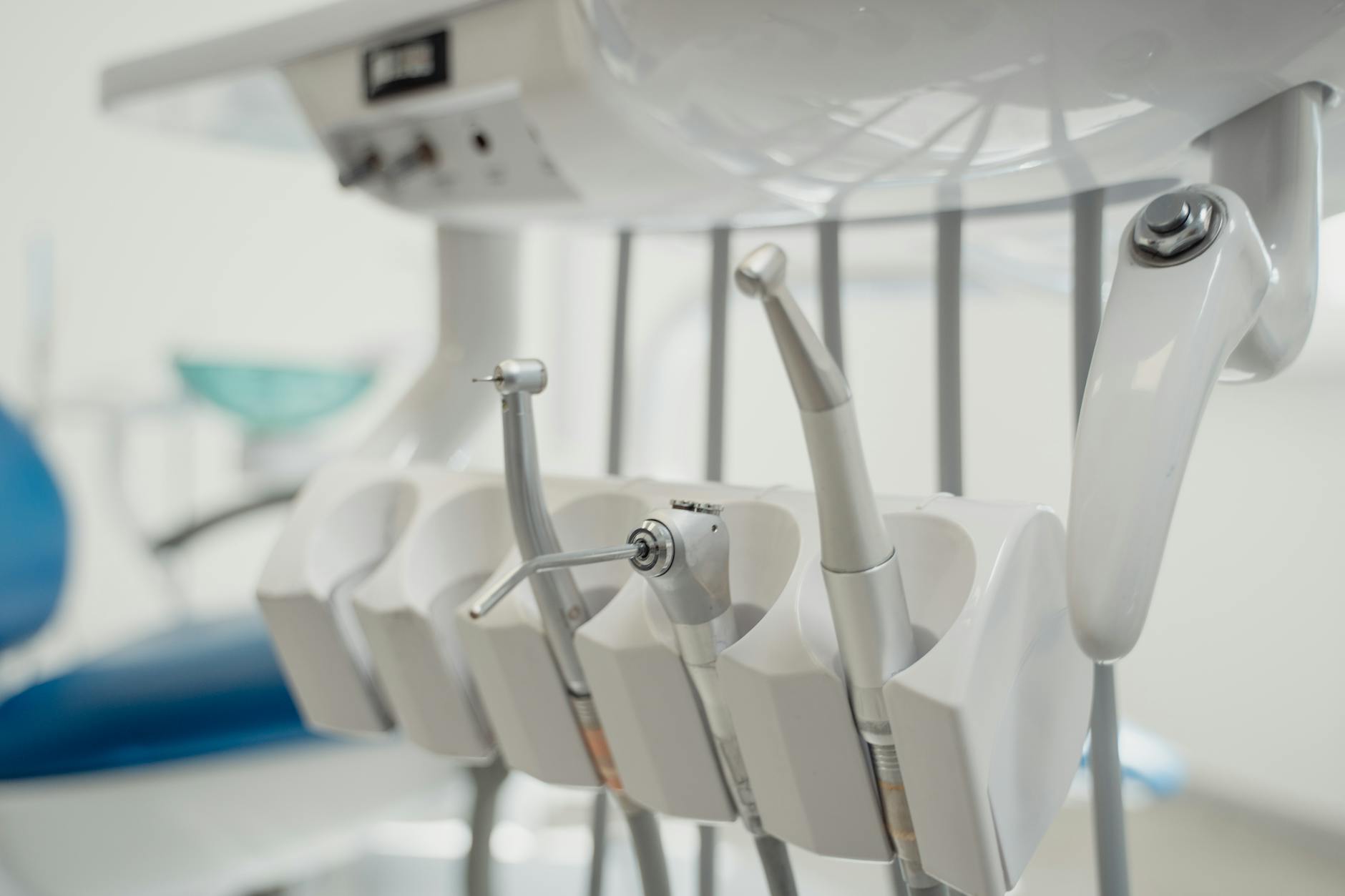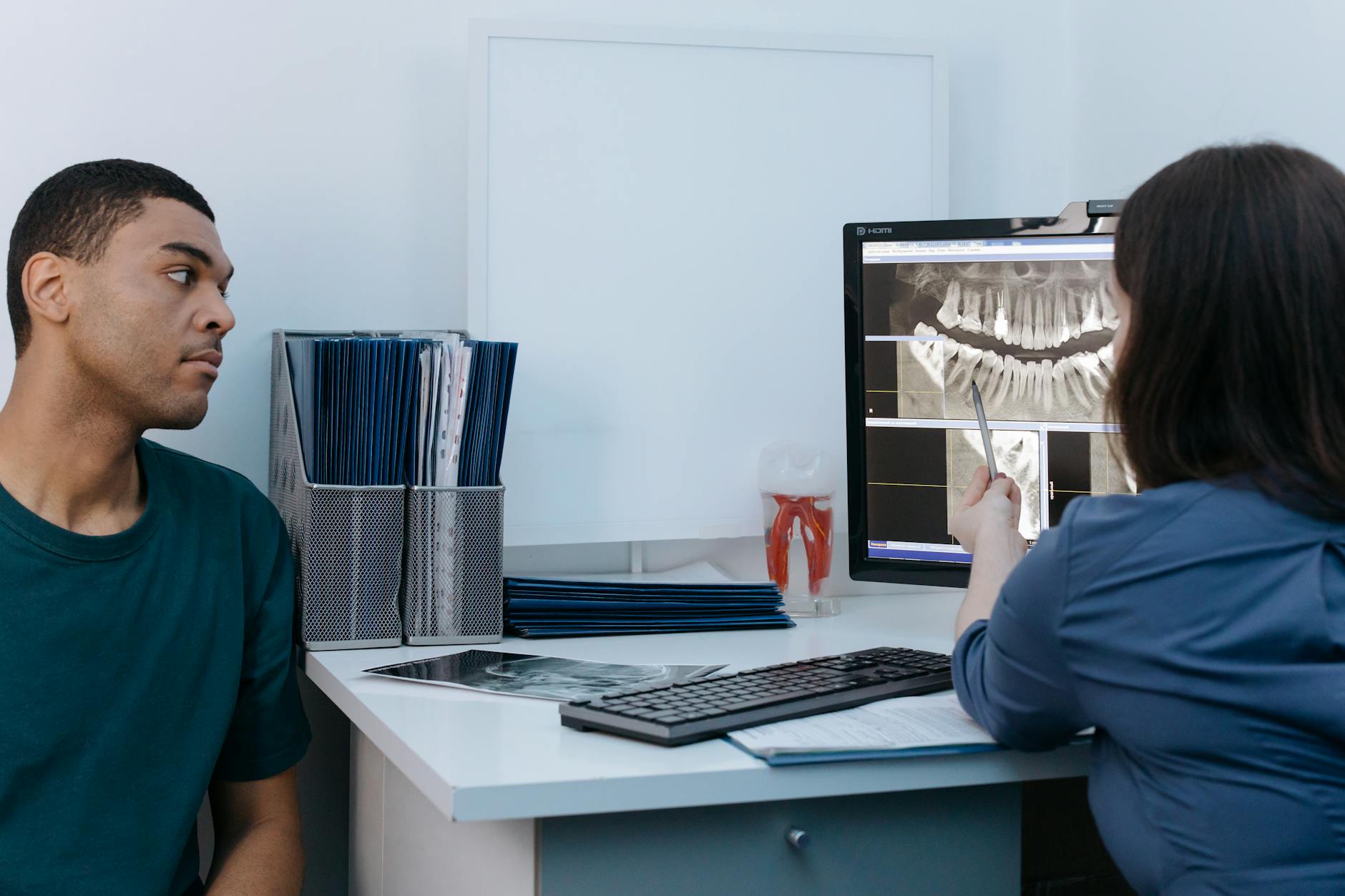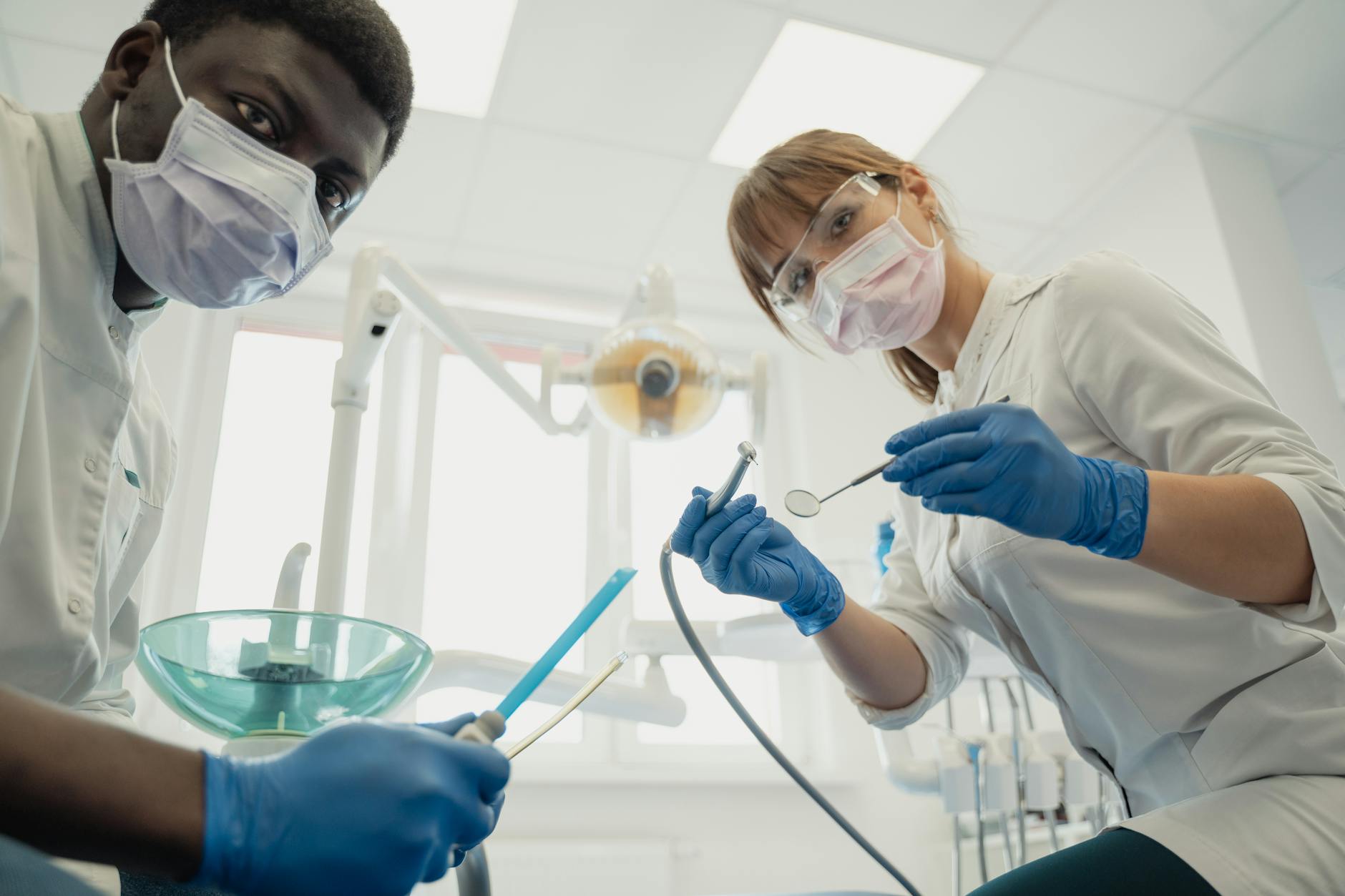Introduction to Digital Wax-Ups
A digital wax-up is a 3D plan of your future smile made on a computer. It blends scans of your teeth with photos and bite records so you can preview tooth shape, length, and alignment before any treatment begins. Many offices also use the plan to make a temporary “mock-up” you can try in your mouth, so you feel the changes, not just see them. This helps you and your dentist agree on goals and limits early.
How it’s made: we capture a digital scan of your teeth, take photos, and record how your jaws meet. Using design software, the teeth are shaped virtually to improve symmetry, proportion, and bite. From that file, we can print a model or make a thin shell to test in. This approach is especially helpful when designing porcelain veneers, because edits are fast and reversible at the planning stage.
- Preview tooth shape, size, and symmetry
- Check smile line and how much gum shows
- Test speech sounds and bite comfort with a mock-up
- See how lips move over the teeth in photos or video
- Estimate how much tooth preparation may be needed
- Improve communication among dentist, lab, and patient
You may hear people compare “digital waxup vs analog test drive.” Both aim to let you test changes before committing. Digital plans are easier to copy, share, and tweak in minutes; analog wax or chairside mock-ups can work well too, but changes often take longer and are harder to track. Either way, the preview is a guide, not a guarantee of the final result, and it should follow a full exam and bite analysis. The same planning method also supports complex crowns and bridges, helping align looks and function before treatment starts.
Understanding Analog Test Drives
An analog “test drive” is a hands-on preview of a proposed smile change made with physical materials, not on a computer. Using a model of your teeth and a wax-up, your dentist places a temporary mock-up in your mouth so you can see and feel the proposed tooth shapes before any teeth are changed. It helps check look, speech, and bite in real life. The mock-up is temporary and removes cleanly.
How it’s made: first, we record your teeth and bite, then a lab adds wax to a model to shape the proposed result. A silicone guide (index) from that model is filled with temporary resin and seated over your teeth, creating a thin shell that shows new length and contours. Small adjustments are made chairside for symmetry and comfort, and photos are taken from different angles. The material is either unbonded or lightly spot-bonded, so it peels off when the evaluation is done.
What you and your dentist look for: tooth length and width, midline, how the smile curve follows the lip, and how much gum shows at rest and when you grin. You’ll test speech sounds (F, V, S) and bite lightly on paper to see if contact points feel even. This preview is especially helpful for additive changes, like rebuilding worn edges or closing small gaps, which are similar to what can be done with conservative dental bonding. If teeth are crowded or rotated, a mock-up can hint at the goal shape, but tooth movement typically needs orthodontics.
Compared with a digital plan, analog is tactile and immediate—you feel lip support and phonetics right away. Its limits are speed and repeatability: edits are manual, and each version takes new material and time. Digital designs update in minutes and share easily; analog shines when you want to sense thickness, edge position, and bite in the mouth. Many cases blend both: design digitally, then validate with an analog try-in. That makes the “digital waxup vs analog test drive” less an either/or and more a team approach, using each method where it’s strongest. If alignment is part of the plan, the preview can inform whether to pair your case with clear aligner treatment before final restorations.
Advantages of Digital Over Analog
Digital wax-ups are faster to create, easier to edit, and simpler to share than analog mock-ups. They allow precise changes to tooth shape and bite with a few clicks, then convert that plan into a printed model or try-in. Because the design lives as a file, it can be revised or duplicated at any point without starting over.
Speed and flexibility are the big gains. If you want a slightly shorter canine or a softer incisor edge, the update takes minutes, and versions can be saved so we can compare options side-by-side. That same file can be sent securely to the lab, used to print a test shell, or revisited months later if you decide to continue with treatment. By contrast, analog changes usually mean re-waxing a model or making a new index.
Digital tools also improve consistency. Measurements for midline, tooth length, and symmetry are made in software and transferred directly to the try-in, so the mock-up you feel matches the plan you saw. Photos and short videos can be overlaid on the design to check lip dynamics before any material touches the teeth. This makes it easier to align esthetics and function at the same time.
Bite planning benefits too. We can evaluate how your upper and lower teeth meet in the virtual setup, spot areas that need clearance, and plan minimal changes to keep healthy tooth structure. If tooth movement is part of the path, the digital plan can guide what to address with aligners first and what to refine with conservative restorations after.
For patients, the result is clearer communication and often fewer appointments to reach a confident decision. You can test a realistic mock-up made from the same digital plan, then keep that file on record for future repairs or upgrades. Shade choices are easier to coordinate as well; if whitening is part of your goal, planning can stage that first so the final design matches your new color after professional teeth whitening. In short, the “digital waxup vs analog test drive” is not a contest—digital speeds up design and sharing, while analog remains useful for feel. Many cases benefit from both.
The Process of Digital Wax-Ups
A digital wax-up starts by capturing your records, then shaping the proposed smile in software so you can preview it before any tooth is changed. The plan can be turned into a printed model or a thin try-in shell that you wear briefly to test look, speech, and bite. Edits happen on the computer in minutes and are easy to track from version to version. In short, it bridges “design on screen” with “feel in mouth,” clarifying the digital waxup vs analog test drive.
First, we gather data: an intraoral scan of your teeth, photos that show your lips and face, and a bite record so the upper and lower jaws meet correctly in 3D. In the software, we set the midline, incisal edge position, tooth length, and smile curve, referencing your facial features. This “virtual patient” lets us check symmetry and proportions before any material is made. Digital smile design on a 3D virtual patient supports symmetry analysis and can be compared with conventional diagnostic wax-ups in the esthetic zone [1].
Next, the approved design is exported to create a printed model or a clear guide. Using that guide, a temporary resin shell is seated over your teeth for a short in-mouth “test drive” to assess lip support, phonetics (F, V, S sounds), and light biting. If you feel a corner too sharp or a tooth too long, we note it and adjust the digital file accordingly. Modern workflows can even use data-driven tools to generate anatomical wax-ups and aid the transfer from design to fabrication, especially in partially edentulous cases [2].
Finally, we lock in the plan. The same file guides conservative tooth preparation (if needed), aligns lab communication, and can be reused later for repairs or upgrades. For complex restorations—including full-arch planning—the digital wax-up helps coordinate esthetics and function from the start; this is often paired with treatment paths like full arch implants when appropriate. Your design, photos, and bite records are saved so future updates build on a known baseline. If you are scheduling records or a mock-up visit, check our current hours for the most up-to-date availability.
Speeding Up Aesthetic Iteration
Digital wax-ups make aesthetic changes faster to test and refine. Because the design lives in software, we can adjust tooth length, edge shape, or symmetry in minutes, then preview the change on screen and in a short in-mouth try-in. Analog test drives can show feel well, but each revision needs new material and lab time. Digital tools shorten that loop, so you reach a confident plan with fewer back-and-forth steps.
The pace comes from a clear “see, feel, tweak, repeat” cycle. We start with accurate scans and photos that capture your smile at rest and in motion. Small edits are made directly on the virtual teeth while keeping reference lines for midline, smile curve, and bite. You and your dentist compare versions side-by-side, mark what you like, and lock in the preferred contours. That exact file is then used to print a model or guide, so the mock-up you feel matches the design you saw.
Turnaround tightens further because versions are easy to save and share. If you want a softer corner or a slightly shorter edge, the change is quick and reversible—no remaking a wax model. We can review options in photos or short videos, checking how the lip tracks over the new edges before any tooth is touched. When you’re ready, a chairside try-in from the same file lets you assess speech and light biting, then we feed your notes right back into the design. In the “digital waxup vs analog test drive,” this is where digital typically wins on speed and traceability while analog still shines for immediate feel.
Fast iteration also supports better function planning. The digital setup shows how upper and lower teeth will meet, so we can preserve healthy structure and avoid high spots in the mock-up. If orthodontic movement is part of the path, the design helps decide what to align first and what to finish with conservative restorations after. The result is a clearer map from first preview to final treatment steps, with changes captured as versions you can revisit later if your goals evolve.
Patient-Centric Design in Digital Dentistry
Patient-centric design means we plan your smile around your goals, comfort, and daily life, not just what the software can do. Digital tools let you see options, try them briefly in your mouth, and give feedback before any tooth is changed. You help choose the look, while we measure function and long-term health so the plan fits you.
In practice, we start by listening: what you like, what you want different, and what matters most—brightness, shape, or keeping tooth structure. We then design with your photos and scans, showing tooth length, edge position, and how your lips move over the teeth in speech and smiling. You can compare versions side-by-side, learn the tradeoffs (for example, length vs. phonetics), and pick the one that feels right. Whether we preview with a printed try-in or a chairside mock-up, the goal is the same: clear choices you can see and feel. That is why “digital waxup vs analog test drive” is less a competition and more a set of tools to support shared decisions.
Function is part of the conversation from the start. We review how your bite will meet, check speech sounds (F, V, S), and make small adjustments so edges feel natural on the lip. If you are missing teeth, digital design helps visualize tooth positions and gaps before making a removable solution; this is especially useful when planning partial dentures because esthetics and chewing function must be balanced carefully. Each change is documented in the file, so you can revisit earlier versions if your preferences shift.
For more complex cases, digital planning supports expectations and timelines. Full-arch or implant-retained options can be previewed to assess lip support, smile display, and cleaning access before fabrication; this is helpful when considering snap-in implant dentures. Photos, short videos, and measurable reference lines make communication straightforward among you, the dentist, and the lab. The result is a design that reflects your priorities, is testable in the mouth, and is traceable from first idea to final treatment.
Comparative Benefits: Digital vs. Analog
Both methods preview your future smile, but they shine in different ways. Digital designs are fast to edit, easy to share, and simple to reproduce exactly. Analog test drives let you feel lip support, speech, and bite right away in your mouth. When people ask about “digital waxup vs analog test drive,” the practical answer is to use each where it’s strongest.
Digital planning speeds decision-making. Small changes—shortening an edge, softening a corner, adjusting symmetry—take minutes, and every version can be saved and compared side by side. The same file can create a printed model or a clear guide, so what you test in the mouth matches what you saw on screen. Because measurements and reference lines live in the file, communication with the lab is consistent and repeatable. That digital record also helps later if repairs or upgrades are needed.
Analog excels at feel. A temporary resin shell made from a wax-up shows how thickness, edge position, and contours interact with your lips and speech in real life. If an “S” sound hisses or a corner rubs the lip, you notice it instantly. Analog is slower to revise because changes are manual and each version takes new material, but the tactile feedback is unmatched. It is especially helpful for additive goals—like rebuilding worn edges or closing small gaps—where the mock-up closely mimics what conservative bonding can achieve.
Most cases benefit from a blended path: design digitally for accuracy and quick iteration, then validate with an analog try-in to confirm comfort, phonetics, and light bite contacts. This approach supports planning across simple and complex care, from single-tooth shape changes to multi-tooth restorations, while aiming to preserve healthy tooth structure. If anxiety makes longer preview visits hard, we can pair this workflow with gentle oral sedation options so you stay relaxed while we test and fine-tune. In short, digital offers speed, traceability, and precise transfer; analog offers immediate, real-world feel. Used together, they reduce surprises and make it easier for you to choose a smile that looks good, feels natural, and functions well.
Case Studies: Digital Wax-Ups in Action
These brief examples show how digital wax-ups help patients preview changes, make choices, and move to treatment with fewer surprises. Each case starts with a scan and photos, a design on screen, and a short in-mouth try-in to confirm look, speech, and light bite. The same file then guides the lab or chairside steps.
Case 1: Worn front teeth and a “short” smile. We scanned, set the midline and smile curve, and lengthened the incisors in software to match the lip at rest. A printed guide made a thin mock-up so the patient could test F and V sounds and see the new edges in conversation. She felt the canines looked sharp, so we softened their corners digitally and reprinted; the approved plan then guided minimal bonding, preserving tooth structure while restoring length and symmetry.
Case 2: A gap between front teeth with uneven edges. Two versions were designed—one that kept a small space for character and one that closed it fully. Side-by-side images helped the patient choose the fuller close, and a chairside try-in confirmed the “S” sound and lip feel. The file transferred directly to the lab for provisional shells, making the move from preview to treatment straightforward. This blended use—quick digital edits plus a real-mouth try—shows why “digital waxup vs analog test drive” is best seen as a team approach rather than a contest.
Case 3: Crowding with chipped edges after grinding. The digital setup first mapped ideal tooth positions and safe edge length. That view made it clear that minor tooth movement would reduce how much drilling was needed later. After short aligner therapy, we updated the design on the new scans and used a guided mock-up to fine-tune edge shape and contact points. Because each version was saved, the patient could compare before/after photos and pick the contour that felt most natural. The final restorations matched the approved design, and follow-up photos showed even contacts and stable speech.
Across these cases, the pattern is consistent: see it on screen, feel it briefly in the mouth, tweak, and then build exactly what was approved. Digital files keep changes traceable, making communication with you and the lab clear at every step.
Improving Communication with Digital Models
Digital models make communication clearer by letting everyone see the same plan, from tooth lengths to smile curve, on a shared screen. Edits are saved as versions, so changes are easy to compare and discuss. This keeps the patient, dentist, and lab aligned on goals, limits, and next steps.
On the screen, we place reference lines for midline, incisal edge position, and smile arc, then overlay your photos to show how teeth relate to your lips at rest and in motion. Short video clips help check speech and lip movement, and notes can be pinned to specific teeth (“soften this corner,” “lift this edge 0.5 mm”). Because the plan is a file, we can review it together in person or remotely, and you can choose between saved versions with confidence.
For the lab, the same digital file drives each step—printed models, try-in shells, and provisional templates—so what you feel in a mock-up matches what you saw on screen. Shared measurements (tooth length, midline, buccal corridor) reduce guesswork, and secure file sharing allows quick feedback before anything is fabricated. In complex cases, virtual simulation can preview lip support and vertical dimension in full-arch planning, improving team discussion and helping set realistic expectations [3].
This record-keeping also helps after the preview. If you prefer Version B’s incisor shape but Version C’s canine length, we can blend those details and save the final as the “approved plan.” Later, if repairs or upgrades are needed, the approved file is our reference point, keeping esthetics and function consistent over time. Photos and screenshots tied to the model turn abstract design terms into visuals that are easy to understand.
Compared with an analog-only approach, digital models reduce “lost in translation” moments. Analog test drives still matter for feel and speech, but digital files make changes traceable, measurable, and shareable. In the digital waxup vs analog test drive discussion, the best communication often comes from using both: refine the look quickly on screen, then confirm comfort with a brief in-mouth try-in.
Future Trends in Digital Wax-Ups
Digital wax-ups are moving toward smarter, more lifelike previews that are faster to make and easier to adjust. The next wave blends facial scans, bite data, and motion into a single “virtual patient,” so we can test how teeth look and work while you speak and smile—before any material is placed. Expect quicker in-office printing of try-ins, more accurate transfers from screen to mouth, and clearer collaboration among you, the dentist, and the lab. In short, the preview will feel closer to real life, with fewer steps.
Artificial intelligence will assist the design, suggesting tooth shapes that match your facial features and age while respecting function. These suggestions are starting points, not decisions—the dentist still tunes the details and checks health. Cloud-based files will make version control simple, so you can compare options side by side at home or in the office. This also streamlines feedback with the lab, reducing remakes and keeping the approved plan consistent through each stage.
Facially driven design will expand beyond static photos. Facial scans and jaw-tracking data will help simulate speech sounds and light chewing on a 3D model, so edges and contacts can be refined before a mock-up is printed. Some try-ins will be made from new, comfortable printable materials that allow slightly longer wear tests, helping you judge phonetics and lip support in daily conversation. The goal is still conservative care: use the preview to guide minimal changes and preserve healthy tooth structure whenever possible.
Augmented reality will likely play a larger role. Live overlays on your smile—viewed on a tablet or phone—can show potential tooth length and contours without placing any material, then confirm the look with a short printed try-in. Shade planning will improve too, using calibrated photos and software to match tooth color more predictably. As these tools mature, the old “digital waxup vs analog test drive” debate fades; most cases will blend fast digital edits with a brief, tactile in-mouth check to confirm comfort and speech. The result is a clearer path from first idea to final treatment, with each change tracked and easy to revisit if your goals evolve.
Limitations of Digital Wax-Ups
Digital wax-ups are powerful planning tools, but they are not the final result. They depend on accurate records and software assumptions, and they cannot fully predict how teeth, lips, and speech will behave in real life. Transfer from screen to mouth also adds small tolerances that may require adjustments. For these reasons, most plans are confirmed with an in‑mouth mock-up before any definitive treatment.
Record quality is the first limit. If scans are distorted, if the bite record is off, or if photos are misaligned, the virtual setup will be less reliable. The software shows static positions well, but it cannot fully model how your lips move, how “F,” “V,” or “S” sounds feel, or how minor habits (like tongue posture) affect edges. That is why a short chairside try‑in remains important to check speech and light biting in real conditions.
Transfer accuracy is the second limit. Going from a digital file to a printed model or guide introduces small errors from design, printer resolution, and materials. Even when the plan is sound, a try‑in shell may seat slightly differently on teeth than it does on the model, and thin areas can flex or fracture during testing. Reviews of template‑guided veneer workflows note that outcomes depend on each step—data capture, design, and stereolithographic fabrication—highlighting that precision is process‑sensitive [4].
Digital color and texture are also simplified. On‑screen enamel translucency, surface luster, and soft‑tissue tone are only estimates; real lighting and skin tones change how teeth look. Gum position can shift with health or therapy, and bone anatomy may limit how far shapes can be lengthened safely. When orthodontic movement, periodontal care, or bite therapy is needed, the wax‑up can show a goal shape, but it will not replace those steps.
Finally, expectations must be set. A digital preview guides direction and lets us communicate clearly, but it is not a guarantee. In the digital waxup vs analog test drive discussion, the most predictable path blends both: use digital to iterate quickly and align the team, then validate comfort, phonetics, and light contacts with a brief in‑mouth mock‑up before moving forward.
Conclusion: The Future of Dentistry
The future of dentistry is precise, patient-centered, and far more predictable. Digital planning lets you see and feel changes earlier, while careful in‑mouth checks keep results grounded in real life. Together, these tools make care faster to plan, easier to communicate, and tailored to your goals and comfort.
Digital wax-ups will continue to connect “what you see” with “what you feel.” You preview tooth shape, length, and bite on screen, then confirm speech and lip support with a short try‑in before any teeth are changed. Analog checks still matter for real‑world feel, but digital files speed design, version control, and sharing with the lab. In simple terms, the digital waxup vs analog test drive becomes a blended workflow that reduces surprises and helps you choose with confidence.
Expect smarter virtual patients built from scans, photos, and bite records, so tooth edges and contacts can be tuned while you smile and speak in natural motion. Design sessions will be more interactive: small edits happen in minutes, versions are saved, and choices are shown side‑by‑side. Because the same file drives models, guides, and provisional steps, what you test in the mouth matches what you approved on screen, making each stage consistent.
This evolution also supports conservative care. By mapping how upper and lower teeth meet before treatment, we can plan minimal changes that protect healthy tooth structure and still achieve your esthetic goals. When a case needs orthodontic movement, implants, or restorative work, the digital plan coordinates the steps so esthetics and function line up from the start. Clear records and photos keep the team aligned and give you a reliable reference for future maintenance.
Most important, the process centers on you. Your preferences guide the look; your comfort and daily speech guide the details. The tools are simply there to make options easier to see, tradeoffs easier to understand, and outcomes easier to trust. That is the future: faster previews, clearer choices, and carefully verified results that look good, feel natural, and support long‑term oral health.
Frequently Asked Questions
Here are quick answers to common questions people have about Digital Wax-Ups: Faster, Better Test-Drives in Glendale, AZ.
- What is the main advantage of a digital wax-up compared to an analog test drive?
The main advantage of a digital wax-up is speed and flexibility. Digital wax-ups allow for quick adjustments to tooth shape and bite on a computer. Edits can be made in minutes and easily shared with dental labs. Analog test drives, while offering a realistic feel, require more time for each revision as they involve manual adjustments. In summary, digital methods excel in planning efficiency, while analog methods are valuable for testing how changes feel in real life.
- How does a digital wax-up improve communication between patients and dentists?
Digital wax-ups improve communication by providing a clear visual plan that can be viewed and discussed on-screen. This plan includes precise measurements and reference lines, making it easier for patients to understand proposed changes. The digital file can also be sent to dental labs, ensuring everyone involved has a consistent view of the treatment plan. This clarity reduces misunderstandings and helps align goals and expectations between the patient and the dental team.
- In what situations might an analog test drive be preferred over a digital wax-up?
An analog test drive might be preferred when tactile feedback is crucial. It allows patients to feel how changes will physically interact with their lips, speech, and bite in real life. This can be particularly useful for testing speech sounds and ensuring that new tooth contours feel natural. Analog methods are ideal when patients need to directly experience the thickness and position of tooth changes, although they take longer to revise.
- Can digital wax-ups completely predict the final outcome of dental restorations?
No, digital wax-ups are guides, not guarantees. They rely on digital modelling, which may not capture all real-life nuances like lip movement, speech sounds, or muscle habits. While they provide a realistic visual preview, small adjustments might still be necessary once the try-in is placed in your mouth. Final results are best confirmed with an in-mouth mock-up to ensure everything feels and functions as expected.
- Do digital wax-ups support treatment planning for orthodontic cases?
Yes, digital wax-ups can support orthodontic treatment planning by providing a virtual model that shows how teeth can be aligned optimally. This visual guide helps in deciding the sequence of aligning teeth and the extent of tooth movement needed. It aids in planning the best approach to achieve esthetically pleasing and functionally effective results, especially when combined with orthodontic techniques like clear aligners.
References
- [1] Bilateral Symmetry in the Aesthetic Area Achieved by Digital Smile Design on 3D Virtual Patient and Conventional Diagnostic Wax-Up-A Comparative Study. (2024) — PubMed:39727430 / DOI: 10.3390/dj12120373
- [2] Creating an anatomical wax-up in partially edentulous patients by means of a statistical shape model. (2022) — PubMed:35072424 / DOI: 10.3290/j.ijcd.b2599407
- [3] Four-Dimensional (4D) Virtual Simulation for Predicting Soft Tissue Support and Vertical Dimension of Occlusion in Full-Arch Implant Therapy – A Proof of Concept. (2025) — PubMed:41061915 / DOI: 10.1016/j.jdent.2025.106142
- [4] Computer-Assisted Porcelain Laminate Veneer Preparation: A Scoping Review of Stereolithographic Template Design and Fabrication Workflows. (2024) — PubMed:39452430 / DOI: 10.3390/dj12100302





